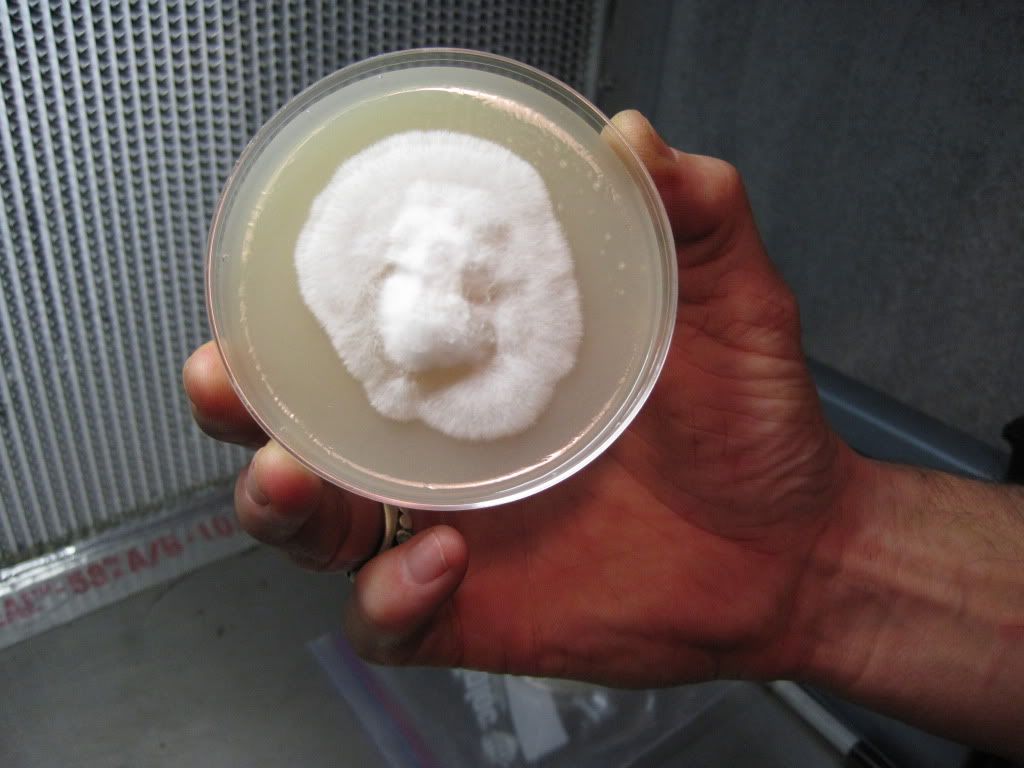How to Use Mushrooms to Get Rid of Atrazine (and Spare Male frogs from “Castration”)
I thought I would post about morels next but good things come to those who wait.
In the meantime we have a bad thing with (at least one) good solution.
Ever heard of Atrazine? It’s in the news right now for altering the reproductive systems of frogs: CNN, Reuters, Fox, BBC
It’s now infamous and controversial. Atrazine has a reputation for groundwater pollution, human health problems, and wildlife damage. It’s also one of the most common herbicides used in the United States. If you’ve ever come in contact with golf courses, Christmas trees, food containing corn, or drinking water, you could have been exposed to it.
It also stays around for a while (from Extoxnet):
“Atrazine is highly persistent in soil. Chemical hydrolysis, followed by degradation by soil microorganisms, accounts for most of the breakdown of atrazine. Hydrolysis is rapid in acidic or basic environments, but is slower at neutral pHs. Addition of organic material increases the rate of hydrolysis. Atrazine can persist for longer than 1 year under dry or cold conditions [21]. Atrazine is moderately to highly mobile in soils with low clay or organic matter content. Because it does not adsorb strongly to soil particles and has a lengthy half-life (60 to >100 days), it has a high potential for groundwater contamination despite its moderate solubility in water [20]. Atrazine is the second most common pesticide found in private wells and in community wells [16].”
Personally, I think the best solution to this problem is organic gardening and farming practices. Barring that, what if there was a mushroom that would eat it?

Photo Caption: Tradd Cotter of Mushroom Mountain holds a petri dish containing a native oyster mushroom species that is consuming the herbicide Atrazine.
When I was visiting Tradd and Olga at Mushroom Mountain last week (and I wrote about How to Kill Fire Ants, Carpenter Ants, and Termites with Mushrooms) I also took photos of an experimental oyster culture acclimated to consume various concentrations of Atrazine.
Tradd and Olga found this mushroom (when Olga tripped over the Clemson, SC stump it was growing on) during freezing temperatures this past January. Since oysters usually prefer slightly warmer temps, Tradd collected the hardier specimen for cold weather bioremediation purposes.
He now has it growing on petri dishes containing the labeled usage rate for Atrazine as well as concentrations 2x and 3x the recommended application rate. This mushroom has adapted quickly to its new toxic food source. Pending tests to determine the mushroom’s efficiency at degrading Atrazine’s active compounds, it will be a remarkable tool for removing Atrazine buildup in the soil.
Tradd tells me this fungus is available for experimentation now if you’d like to contact him through the Mushroom Mountain website.
9 thoughts on “How to Use Mushrooms to Get Rid of Atrazine (and Spare Male frogs from “Castration”)”
Comments are closed.


Phil - March 2, 2010 4:39 pm
Thanks for letting me know about your post. I was aware of the frog problem but not about the use of mushrooms as a possible remediation.
Sustainahillbilly
Twitter: appalachianfeet
- March 2, 2010 5:14 pm
You’re welcome, and thanks for running such an informative mycology blog!
Olga - March 2, 2010 6:54 pm
love the frog picture, LOL. just wanted to add that oyster mushrooms are able to break down alot of other poisons that evil companies produce and include in their evil products. Some of those are: hydrocarbons, chlorinated compounds, PCBs and persistend agricultural pesticides. The list just goes on and on.
there is even a mushroom out there that breaks down indigo, which is very poisonous to amphibians and fish.
DavidFunderburk - March 3, 2010 9:34 am
Wow, great article.
Pingback: Herbicide Turns Male Frogs Female | InPurplish
Meredith - March 4, 2010 11:18 am
That is wonderful news! I had heard they were using mushrooms to clean up one of the worst toxic superfund sites in California, and having enough success to be excited about it. Now if we’d only stop polluting, we might have a chance to clean up after ourselves after all…
Sustainahillbilly
Twitter: appalachianfeet
- March 5, 2010 10:52 am
I’m excited we have found something that might help backtrack some of our less responsible human moments.
Pingback: How to Find Edible Morel Mushrooms (With Recipes) | Appalachian Feet
Pingback: News: Eliza on TV, Upcoming Events, and Our Favorite “How To” Articles | Appalachian Feet